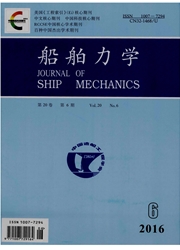

 中文摘要:
中文摘要:
陡波条件下波浪沿柱体的非线性爬升效应一直是水动力学研究的热点问题,并成为半潜平台气隙预报的一个重要方面。文章基于N—S方程和连续性方程建立了三维数值波浪水槽,采用类似于深水试验池的摇板造波方式生成波浪。详细研究了多种网格划分形式,并与试验测量值进行对比,确定了最优的网格划分方案,同时保证了数值方法的可行性。随后,在该数值水槽内对半潜平台周围波浪爬升效应进行了数值模拟。整个流域采用分块耦合网格划分技术,全部生成六面体结构化网格,提高了迭代运算的速度和求解的精度,并可捕捉到更为光顺的自由液面。结果表明,该方法能够对平台周围的波面分布进行详细的数值模拟,并预报出波浪非线性较强的区域,为模型试验前确定浪高仪的安装位置提供了重要依据。计算得到的波面分布和模型试验相似,进一步证明了该数值方法模拟波浪绕射和爬升等现象是可行的。此外,文中还从物理现象上模拟并分析了波浪沿立柱的绕射和爬升过程,可为今后进一步研究波物之间的非线性相互作用提供参考。
 英文摘要:
英文摘要:
The effect of wave non-linear run-up along columns in steep waves was a hot topic, and also an important aspect in air-gap prediction of semi-submersible. In this paper, 3D numerical wave tank is created based on N-S equations and continuity equations, in which regular wave is generated based on flap wavemaker similar in physical deepwater offshore basin. Model tests are conducted to testify this numerical method and obtain the optimal mesh strategy. Wave diffraction and run-up effects are simulated in this nu- merical wave tank. Hexahedral meshes are created in all fluid regions based on multi-block coupling tech- nology in order to increase iteration speed and accuracy of the solution, also capture free surface much smoothly. Results indicate that distributions of water surface around semi-submersible can be obtained in detail through this method. Moreover, the areas of strong non-linear wave around platform can also be predicted, which is also a key basis to determine installation locations before model tests. Wave surface is similar with model test which indicates further that this numerical method is feasible primarily in run-up sim-ulation. In addition, the process of wave diffraction and run-up along columns is also simulated from physical phenomenon, which will provide an important reference for further research on the non-linear interac, tion between wave and offshore structures.
 同期刊论文项目
同期刊论文项目
 同项目期刊论文
同项目期刊论文
 期刊信息
期刊信息
